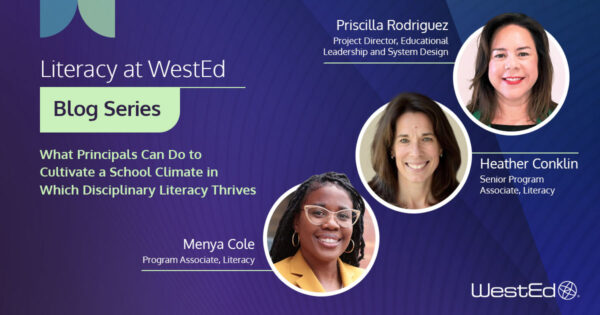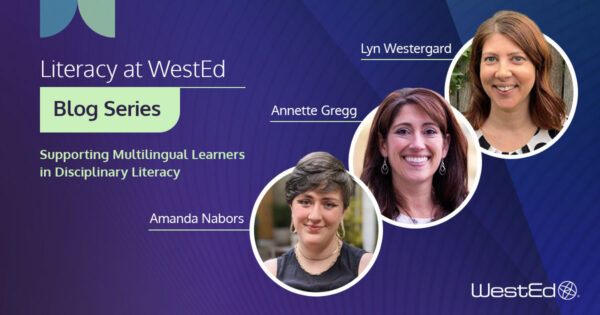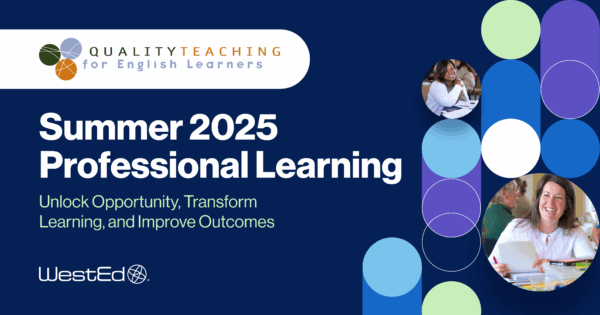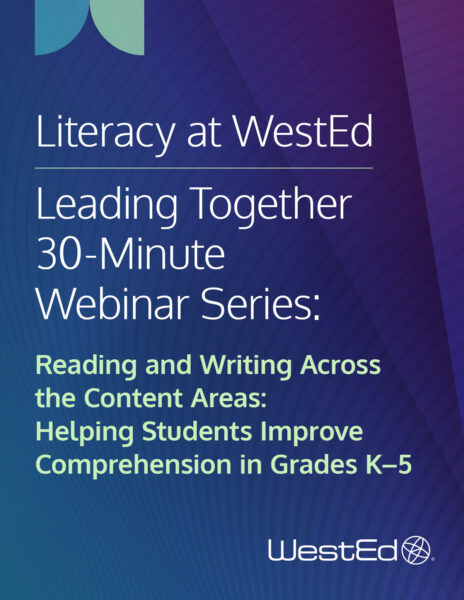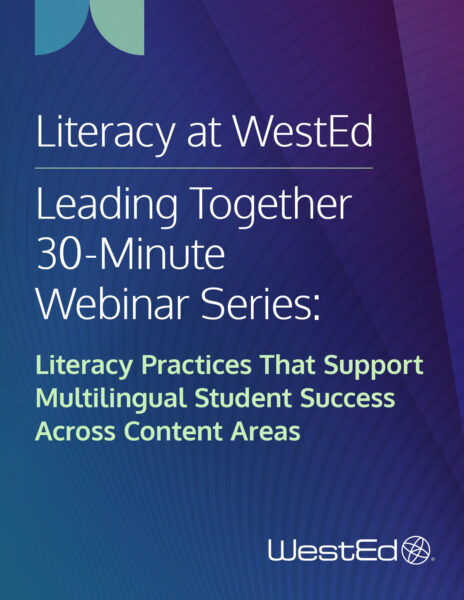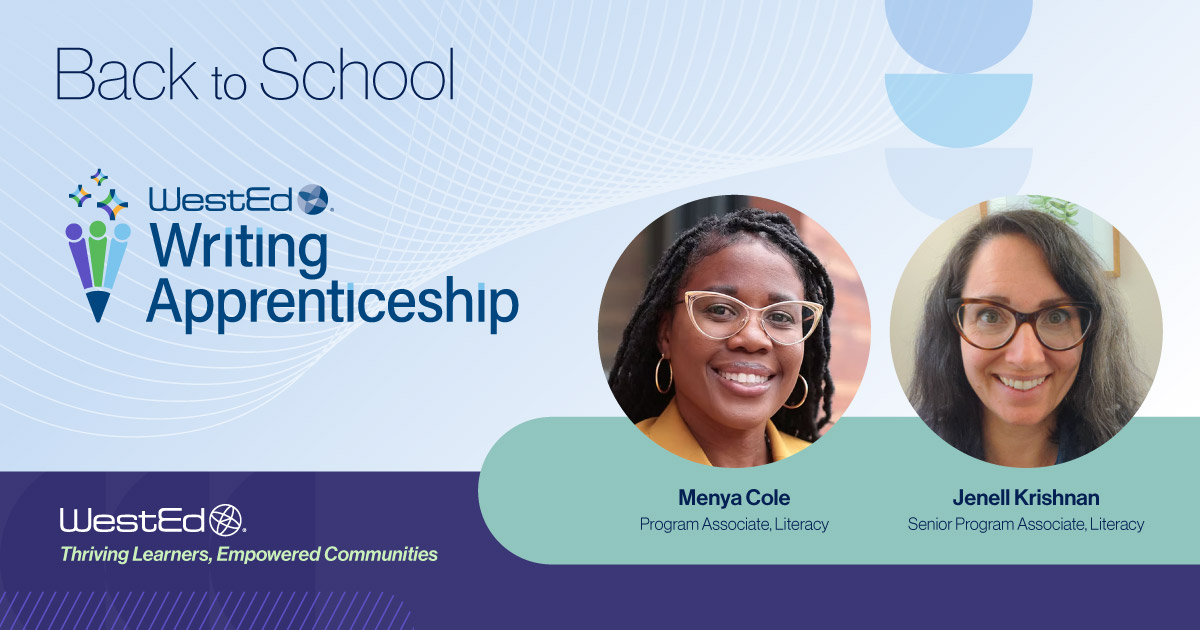
June 5, 2025
Across the country, educators in every discipline are confronting a pressing challenge: Many middle and high school students feel disconnected from the writing they do in school even though they actively write in their personal lives—through group chats, social media comments, lyrics, blog posts, fan fiction, and code. At the same time, teachers feel pressure to meet new standards, respond to the emergence of generative artificial intelligence (GenAI), and support all learners in ways that will promote their success.
Research shows that when teachers are supported in implementing an instructional framework that has pedagogical routines for supporting discipline-specific writing, their students are apprenticed into powerful ways of writing that build on what they already know and do.
WestEd’s all-new Writing Apprenticeship is a professional development model and instructional approach for middle school and high school English language arts and history/social studies educators. Designed to support writing instruction across topic areas, Writing Apprenticeship engages students in new ways of writing, thinking, talking, and reasoning in supportive classroom environments.
At the heart of this teacher professional learning is a joyful belief: Writing belongs to every learner in every classroom. Learning comes alive when educators receive support to teach writing as a tool for connecting with real audiences, exploring content, reasoning through discipline-specific concepts, and achieving their goals.
In this Q&A, Writing Apprenticeship developers Menya Cole and Jenell Krishnan reflect on the
- power of authentic writing to transform classrooms,
- ways that cultivating a metacognitive writing culture can help every learner thrive, and
- current opportunities and challenges of GenAI for writing instruction.
Cole and Krishnan serve as experts on WestEd’s Literacy team.
Note: This conversation has been edited for length and clarity.
When learners write for authentic purposes and audiences, writing becomes more than a task. It becomes a meaningful act of communication. The classroom transforms into a space where students engage as thinkers, storytellers, and changemakers.
When learners see writing as meaningful and connected to their lives, they write more and better (Applebee & Langer, 2013). We acknowledge learners as writers because of all the ways they engage in writing (e.g., text messaging, storytelling, journaling, blogging, fan fiction writing, coding).
In Writing Apprenticeship, we work with grades 6–12 English language arts (ELA) and history and social studies teachers. Teachers learn to design opportunities that invite learners to write as literary critics, as storytellers, as political analysts, as historians, and as civic thinkers.
For example, one Writing Apprenticeship participant and multilingual specialist shared that last year she spent more time on structure and paragraph frames. Now, she includes more authentic audiences and purposes for the types of writing her students are invited to do.
Our research shows that these learners are prepared to write for discipline-specific purposes and for audiences that matter to them.
In writing, metacognition (thinking about one’s thinking) is a powerful tool for self-awareness and growth. When learners are explicitly taught to make their writing processes visible to themselves and others, they not only become more effective writers but also develop stronger motivation and confidence (Graham, 2018). At the center of the Writing Apprenticeship instructional framework is the metacognitive conversation, which helps every learner thrive. This is grounded by 30 years of Reading Apprenticeship research and practice (Greenleaf et al., 2023).
This kind of metacognitive writing culture can be transformative, especially for English Learners, students with disabilities, and those whose talents haven’t been cultivated or acknowledged in academic settings. When learners are encouraged to reflect on their writing choices and processes, they build awareness of themselves as capable writers who make purposeful decisions. Through consistent support and opportunities to talk about what they’re writing about and how they’re shaping their ideas, learners grow individually and as a classroom community of writers.
Teachers play a crucial role by making their own thinking visible. In the Writing Apprenticeship classroom, teachers use the Writing Think Aloud routine. This happens when teachers pause while drafting to think about and verbalize their mental processes, questions, and revisions in real time. In these classrooms, writing is a powerful tool for discipline-specific learning and for students to achieve their own goals. Reflecting on recent professional learning, a grade 7 social studies teacher explained that she now knows that showing students the writing process and not just the finished polished exemplar is equally important and that to do so she will be integrating Writing Think Alouds while drafting in front of students. The students in this teacher’s classroom will receive opportunities to experience how social scientists make decisions while writing, a powerful way of apprenticing students into the discipline.
When learners are positioned as strategic decision-makers in their own writing process, GenAI becomes a resource for deepening their thinking—not replacing it (The WRITE Center, 2025). Thoughtfully used, GenAI tools can support students in collaborative and generative ways. These tools can build on learners’ knowledge, linguistic assets, and curiosity to spark new ideas, expand vocabulary, and open doors to unfamiliar genres and writing styles. We’ve seen how this kind of collaboration can amplify learners’ voices, making writing a more joyful, empowering, and expansive experience—especially for students whose brilliance as communicators and storytellers isn’t fully recognized in school settings.
At the same time, GenAI presents challenges. As Beck and Levine (2024) caution, GenAI tools—trained on massive data sets—often reflect and reinforce dominant norms around language, tone, and genre. Learners in their study noted that GenAI “took out all of our personality” or “made you write like a robot.” When used without a critical lens—or without the student in the loop—GenAI can risk erasing learner voice, agency, and the deeply personal work of writing.
That’s why in Writing Apprenticeship we support teachers to engage strategically with GenAI in ways that strengthen instruction and prioritize metacognitive awareness. We offer experiential learning that helps educators integrate Writing Think Alouds into their practice, modeling the writer’s decision-making process in real time.
In addition, during professional learning, teachers have access to intentionally designed GenAI-powered apps—such as Writing Out Loud*—that simulate a writer’s thinking as they draft in their area of expertise. Teachers input the type of writer they wish to learn from (e.g., storyteller, political analyst, lawyer) and the genre, purpose, and intended audience. These inputs provide the app with the necessary parameters to develop an exemplar Writing Think Aloud to support the teacher’s growth. By combining pedagogical intentionality with GenAI’s capabilities, we can ensure that writing instruction remains human-centered—fostering student voice, agency, and authentic engagement in the writing process. In Figures 1 and 2, we offer a look into how Writing Out Loud simulates the mental processes that are specific to writing to both inform and persuade a community-based organization.
Figure 1. Chat Exchange With Writing Out Loud Chatbot

Figure 2. Writing Think Aloud Generated by Writing Out Loud App

This focus helps teachers and their learners to reflect on their choices as writers, recognize their own voices and intentions, and develop the agency needed to navigate both human and machine-generated texts. As developers of Writing Apprenticeship, we agree with Beck and Levine’s (2024) argument that it’s essential to center human imagination and agency in writing.
Sign Up for Writing Apprenticeship Professional Learning
At WestEd, we’re committed to supporting educators in bringing this instructional approach to their own classrooms and communities. If you’re working to deepen learner engagement, foster authentic collaboration, and navigate the evolving landscape of writing instruction—including GenAI—we’d love to partner with you. Let’s work together to imagine what’s possible for learner writing in your classroom, your school, or your district.
Ready to strengthen authentic writing support? Contact us. →
About the Authors
Jenell Krishnan, PhD, is a developer of Writing Apprenticeship. For two decades, Krishnan’s work has been at the intersection of literacy, language, and technology. She strengthens the connection between research and practice by engaging teachers, school leaders, and faculty to improve literacy teaching and learning.
Menya Cole, MS, is also a developer of Writing Apprenticeship. She is an experienced educator with over 15 years of dedicated service in elementary and middle school settings as both a teacher and literacy coach.
References
Applebee, A. N., & Langer, J. A. (2013). Writing instruction that works: Proven methods for middle and high school classrooms. Teachers College Press.
Beck, S. W., & Levine, S. (2024). The next word: A framework for imagining the benefits and harms of generative AI as a resource for learning to write. Reading Research Quarterly, 59(4), 706–715.
Graham, S. (2018). A revised writer(s)-within-community model of writing. Educational Psychologist, 53(4), 258–279.
Greenleaf, C., Schoenbach, R., Friedrich, L., Murphy, L., & Hogan, N. (2023). Reading for understanding: How Reading Apprenticeship improves disciplinary learning in secondary and college classrooms (3rd ed.). Jossey-Bass.
The WRITE Center. (2025). The future of writing instruction and research at the secondary level: Recommendations from the WRITE Center summit. University of California, Irvine.
*Apps were developed using PlayLab.ai, Playlab Education, Inc., a 501(c)3 nonprofit.
